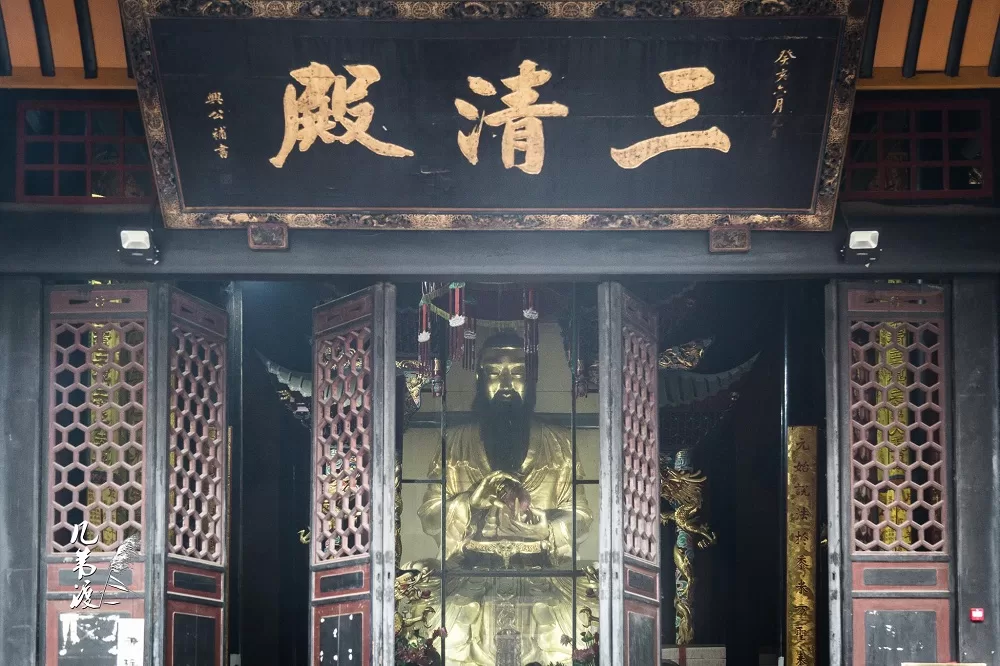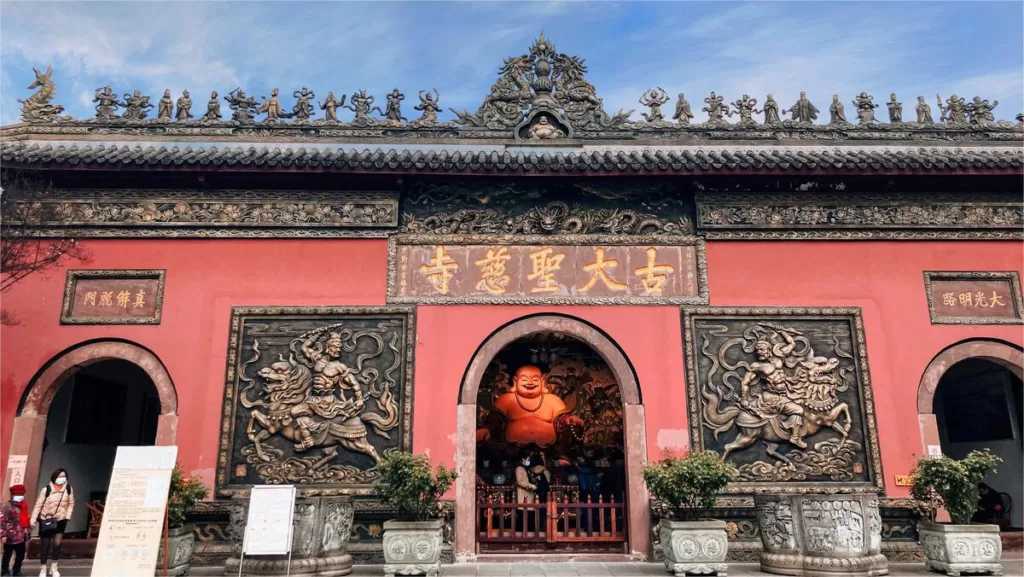Qingyang Palace (青羊宫) is a Taoist temple located in the heart of Chengdu, the capital city of Sichuan Province in southwestern China. It is one of the oldest and most famous Taoist temples in the region, with a history that dates back over 2,000 years.
The temple was first built during the Zhou Dynasty (1046 BC – 256 BC) and has undergone numerous renovations and expansions over the centuries. Today, it covers an area of over 10,000 square meters and consists of multiple halls, courtyards, and gardens.
Qingyang Palace is renowned for its beautiful architecture, which blends traditional Chinese design elements with Taoist symbolism. The most notable structures within the temple include the Hall of Three Purities, the Hall of the Heavenly Kings, and the Sanqing Hall.
In addition to its cultural and historical significance, Qingyang Palace is also a popular destination for tourists and locals alike. Visitors can participate in various religious activities, such as burning incense and praying for good fortune, or simply admire the temple’s stunning beauty and serene atmosphere.
Table of Contents
- Basic Information
- Location and Transportation
- Highlights of Qingyang Palace
- Vlog about Qingyang Palace
- History of Qingyang Palace
- Useful Tips from Genuine Reviews
- Attractions Near Qingyang Palace
- Other Temples in Chengdu
Basic Information
| Estimated Length of Tour | 1 hour |
| Ticket Price | 10 RMB |
| Opening Hours | 6.00 – 17.30 |
| Telephone Number | 0086-028-87766584 |
Location and Transportation
Qingyang Palace is located in the central district of Chengdu, the capital city of Sichuan Province in southwestern China. Its address is No. 9, West Section 2, Qingyang Road, Qingyang District, Chengdu, Sichuan Province, China. The temple is easily accessible by public transportation.
Bus: Take bus 34, 35, 58, 82, 151, 165, 280, 1031, or 1079 and get off at Qingyang Palace Stop (青羊宫站).
Subway: Take subway line 5, get off at Qingyang Palace Station (青羊宫站), and get out from Exit C.
Highlights of Qingyang Palace
Sanqing Hall

Sanqing Hall, also known as Wuji Hall, is the main hall of Qingyan Palace. It was originally built during the Tang Dynasty and was rebuilt in the 8th year of the Kangxi reign in the Qing Dynasty (1669 AD). The hall is square-shaped, with a foundation that spans 40 meters in length and a total area of 1,600 square meters. The exterior columns are adorned with intricate wooden carvings, including designs of children playing and lions playing with balls. In front of the hall, on the left, there is a bell named “Youming Bell,” which was cast during the Ming Dynasty and weighs over 3,000 kilograms. On the right, there is a drum, and on the first and fifteenth days of each lunar month, as well as during grand celebrations, the bell is rung, and the drum is struck. Inside the hall, there are 36 large pillars, with eight wooden pillars representing the Eight Heavenly Kings of Taoism and 28 stone pillars symbolizing the 28 constellations in the sky.
Hunyuan Hall

Hunyuan Hall is the second most significant hall in Qingyan Palace and is dedicated to the Taoist deity, Taishang Laojun, one of the highest deities in Taoism and a representation of Taiqing Daode Tianzun. The hall was rebuilt during the Guangxu reign in the Qing Dynasty and covers an area of 616 square meters. It features 26 stone pillars and 2 wooden pillars, each adorned with intricate carvings of animals such as deer, phoenixes gazing at the moon, and lions playing with balls. These carvings are lively and vivid. During the reign of Emperor Zhenzong of the Song Dynasty, the emperor held Taoism in high regard and honored Taishang Laojun as the Hunyuan Shangdi. The central figure worshipped in the hall is the “Hunyuan Ancestor Master.” Laojun is depicted with a kind expression, holding a Hunyuan Qiankun Circle in his hand. When the circle is stretched, it forms the character “一” (one), symbolizing the original state of the world in chaos. Laojun is credited with creating the universe, from “Dao creating one, one creating two, two creating three, and three creating all things.” In the rear of the hall, the statue of Cihang Zhenren, known as Guanyin Bodhisattva in Buddhism, is worshipped.
Bagua Pavilion

Situated between Sanqing Hall and Hunyuan Hall, the Bagua Pavilion is a prominent representation of Taoist teachings and is the most well-preserved and ornately designed structure in Qingyan Palace. It houses a statue of Laozi riding a green ox. The pavilion stands about 20 meters tall, 17 meters wide, and covers nearly 300 square meters. Its layout is compact and elegantly designed, with a three-tiered structure built on a raised platform. The stone base is square, while the pavilion itself is circular, reflecting the ancient Chinese concept of “heaven being round and earth being square.” The pavilion features double-eaved roofs with dragon-headed ridge ornaments, turtle-patterned screens, and cloud-patterned carved windows. The south-facing main entrance is adorned with a relief of the twelve zodiac animals and a Taiji diagram, which is simple yet elegant in design. The entire pavilion is constructed from wood and stone, with the components intricately joined together without a single nail or peg.
Bronze Goats

Within Sanqing Hall, there is a pair of bronze goats, commonly known as “Qingyang,” which are the most treasured artifacts of Qingyan Palace. The left side features a single-horned bronze goat, while the right side has a double-horned bronze goat. The single-horned goat is particularly unique, as it embodies characteristics of all 12 Chinese zodiac animals: mouse ears, an ox body, tiger claws, a rabbit back, dragon horns, a snake tail, a horse mouth, a goat beard, a monkey head, chicken eyes, a dog belly, and a pig rump. The single-horned goat was donated during the first year of Emperor Yongzheng’s reign by Zhang Penghe, a grand scholar of the Qing Dynasty. The double-horned goat was donated in the 9th year of Emperor Daoguang’s reign by a devout follower named Zhang Kesi from Chengdu. The base of each goat is inscribed with details of the donation.
Vlog about Qingyang Palace
History of Qingyang Palace
Qingyang Palace, originally named Qingyangsi, was founded during the Zhou Dynasty. Its history took a significant turn during the Tang Dynasty when, in 881 AD, Emperor Xizong of Tang sought refuge from the Huang Chao Rebellion in Sichuan and used the site as a temporary palace. In 883 AD, the emperor issued an edict renaming the site to Qingyang Palace.
During the Five Dynasties period, it was renamed “Qingyang Guan,” but the name “Qingyang Palace” was restored during the Song Dynasty and has remained unchanged ever since.
The palace suffered significant damage during the Ming Dynasty due to natural disasters and warfare, leading to the destruction of many of its original Tang and Song structures. The current buildings date back to the Qing Dynasty, having been reconstructed between 1667 and 1671 during the reign of Emperor Kangxi.
Qingyang Palace faced another challenging period during the Cultural Revolution in 1966, when it was severely impacted, and the resident Taoist priests were expelled and forced to return to secular life. Following China’s Reform and Opening-Up, the palace underwent several restorations.
In 1984, under the leadership of Taoist priest Zhang Yuanhe, Qingyang Palace collaborated with the Bashu Book Society of Sichuan to reprint the “Daozang Jiyao,” the only surviving Qing Dynasty woodblock edition of this Taoist canon. This effort helped preserve an essential part of Taoist literature.
Qingyang Palace was designated a National Key Taoist Temple for the Han Chinese region by the State Council on April 9, 1983. It was later listed as a Provincial Key Cultural Relic Protection Unit by Sichuan Province on December 27, 2002. In 2004, to protect the original bronze sheep donated by Qing Dynasty Prime Minister Zhang Penghe, the statue was preserved as a cultural relic, and a replica was unveiled for public veneration.
Useful Tips from Genuine Reviews
Famous Bronze Rams: The most famous attraction at Qingyang Palace is the pair of bronze rams in front of the Sanqing Hall. According to folklore, rubbing the corresponding body parts of the bronze ram to where you feel discomfort is believed to cure ailments.
Vegetarian Meals: Within Qingyang Palace’s tea garden, there’s a vegetarian meal service starting at 11:30 am. Priced at 15 yuan, it includes four vegetarian dishes and rice. After the meal, you can also enjoy a cup of tea nearby.
Sanqing Hall: This is where the temple conducts morning and evening rituals, typically at 4 pm daily. If coincidentally there’s a chanting session, it’s essential to maintain silence. If you follow the faith, joining in is acceptable. Avoid wandering around or creating noise during this time.













At the entrance of the Three Clear Palaces (三清殿), I saw many people enthusiastically rubbing the Big Green Goat. As more people gathered, we even had to line up. I asked someone about it, and they told me that this goat is very magical; you rub where you feel uncomfortable, and it will heal.